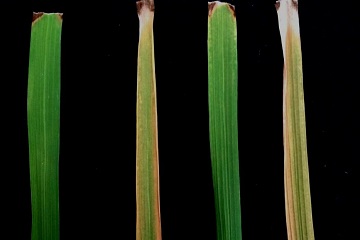The Researcher of IPB Controlling Bacterial Leaf Blight Disease on Rice

Rice is one of the important agricultural products in Indonesia. The production has been fully supported by infrastructure including research and development as well as government regulations in pricing. One of the problems in rice cultivation is rice plants that we plant attacked by diseases, many types of diseases that attack rice plant one of which rice blast disease, we know that plants attacked by blast disease the average will decrease productivity of the rice harvest. Disease damage to rice can greatly reduce yield. They are mainly caused by bacteria, viruses, or fungi. Planting a resistant variety is the simplest and, often, the most cost effective management for diseases. Rice blast, caused by the fungus Pyricularia oryzae Cav., is one of the most important diseases of rice. For stage critical attack blast disease is when the rice 1 month old (upland rice), when the rice plants entering the maximum tillering, when entering it contains, and the last time the rice plants into early flowering, this is the critical condition of the attacks to blast disease.
Rice blast caused by Pyricularia oryzae is a serious pest of rice. Susceptibility to blast increases with increasing plant N content which can arise by application of fertilizer N. Special emphasis was directed to natural infection with leaf and neck blast under interaction between chemical N fertilization and algalization with the two inocula. Rice Blast has been singled out as one of the main causes limiting production. Variety screening to blast disease has failed due to breakdown of resistance within short periods. Pathogen variability is suspected to cause this. The higher and widespread of blast disease in rice plants, encouraging efforts to control the disease. One of them the use of synthetic chemical compounds. But the production costs, security, and not environmentally friendly are constrain for utilizing this compounds. Therefore, there is growing interest in discovering and developing new, improved fungicides based on natural products as well as introducing alternative measures such as biocontrol agents to manage plant diseases. Non-pathogenic phyllosphere actinomycetes of rice are capable of controlling Bacterial Leaf Blight disease in rice. However, the use of actinomiset filosphere as biological agent of leaf blast disease control on paddy have never been done.
This current issue encouraged Wiwiek Harsonowati, the student of Graduate Studies, on Microbiology Study Program, of Bogor Agricultural University (IPB) implementing research program on "Aktinomiset Filosfer Penghasil Senyawa Bioaktif sebagai Agens Hayati Pengendali Penyakit Blas Daun Padi = Rice Phyllosphere actinomycetes as Biocontrol Agent of Bacterial Leaf Blight Disease on Rice. This research is under the supervision of Prof. Dr. Aris Tri Wahyudi, M.Si and Dr. Ir. Rika Indri Astuti, M.Si.
Healthy rice leaf samples were obtained from rice fields affected by blast disease in Situgede, Sukabumi and Jasinga, West Java. A total of 75 actinomycetes isolates have been isolated from the rice plant philosphere. 38 isolates were able to inhibit the growth of P. oryzae in-vitro using a double culture method, and 27 isolates included nontogenous actinomycet group through hemolytic test, hypersensitivity and pathogenicity.
Analysis of 16S rRNA gene sequences on 22 selected isolates showed that the isolates were included in the genus Streptomyces (15 isolates), Micromonospores (2 isolates), Lentzea (2 isolates), Saccharothrix (2 isolates), and Gordonia (1 isolate). Detection of gene encoding enzymes that play a role for biosynthesis of bio-synthetic compounds of nonribosomal peptide synthase (NRPS) and polymeride synthase (PKS-I) showed that 21 isolates (95.45%) had NRPS gene and 14 isolates (63.6 percent) had PKS-I.
Eleven actinomycetes isolates with growth characteristics that do not form aggregates in liquid media were further tested to control blast attacks in greenhouses. The results showed the application of Phyllosphere actinomycetes able to suppress blast disease by 77 to 88 percent. Isolates JSN1.9, SKB2.14, and SKB2.3 were the three best isolates in suppressing blast disease symptoms in greenhouse applications and the three isolates were identified as Gordonia terrae, Streptomyces griseus, and Streptomyces albolongus.
The results of this study has indicated that the highest percentage of inhibition of blast disease was in greenhouses compared to the application of isolates in soil bacteria and rhizosphere. Therefore, the actinomycetes of the philosphere is more potential to be utilized as biological agent of rice blast disease control. (Wied)



